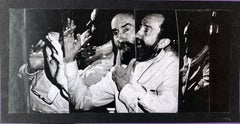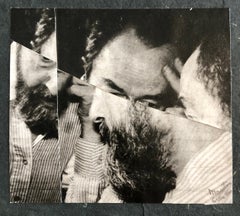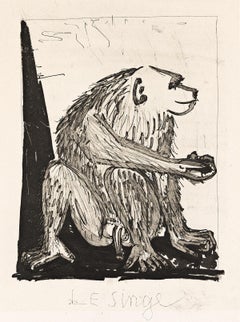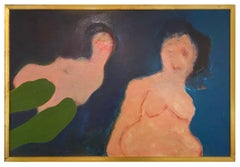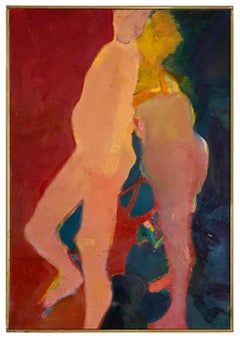Martin Sumers Art
to
3
3
3
Overall Height
to
Overall Width
to
3
3
2
6
6,886
3,210
2,514
1,217
3
3
Artist: Martin Sumers
Vintage Abstract Expressionist Hyman Bloom Photo Collage Assemblage Photograph
By Martin Sumers
Located in Surfside, FL
This is a unique original collage, decoupage style of Jiri Kolar, This is an exceptional artwork which was part of a collaboration between Hyman Bloom and fellow artist and his very good friend Martin Sumers. This is pencil signed by Martin Sumers.
Provenance: Acquired from the Sumers estate collection.
Hyman Bloom (March 29, 1913 – August 26, 2009) was a Latvian-born American painter. His work was influenced by his Jewish heritage and Eastern religions as well as by artists including Altdorfer, Grünewald, Caravaggio, Rembrandt, Blake, Bresdin, James Ensor and Chaim Soutine. He first came to prominence when his work was included in the 1942 Museum of Modern Art exhibition "Americans 1942 -- 18 Artists from 9 States". MoMA purchased 2 paintings from the exhibition and Time magazine singled him out as a "striking discovery" in their exhibition review.
His work was selected for both the 1948 and 1950 Venice Biennale exhibitions and his 1954 retrospective traveled from Boston's Institute of Contemporary Art to the Albright Gallery and the de Young Museum before closing out at The Whitney Museum of American Art in 1955. In a 1954 interview with Yale art professor Bernard Chaet, Willem de Kooning indicated that he and Jackson Pollock both considered Bloom to be “America’s first abstract expressionist”, a label that Bloom would disavow. Starting in the mid 1950s his work began to shift more towards works on paper and he exclusively focused on drawing throughout the 1960s, returning to painting in 1971. He continued both drawing and painting until his death in 2009 at the age of 9
Hyman Bloom (né Melamed) was born into an orthodox Jewish family in the tiny Jewish village of Brunavišķi in what is now Latvia, then part of the Russian Empire
At a young age Bloom planned to become a rabbi, but his family could not find a suitable teacher. In the eighth grade he received a scholarship to a program for gifted high school students at the Museum of Fine Arts. He attended the Boston High School of Commerce, which was near the museum. He also took art classes at the West End Community Center, a settlement house. The classes were taught by Harold Zimmerman, a student at the School of the Museum of Fine Arts, who also taught the young Jack Levine at another settlement house in Roxbury. When Bloom was fifteen, he and Levine began studying with a well-known Harvard art professor, Denman Ross, who rented a studio for the purpose and paid the boys a weekly stipend to enable them to continue their studies rather than take jobs to support their families.
He took Bloom and Levine on a field trip to the Museum of Modern Art in New York, where Bloom was impressed by the work of Rouault and Soutine and began experimenting with their expressive painting styles.
In the 1930s Bloom worked sporadically for the Public Works of Art Project and the Federal Art Project (WPA), He shared a studio in the South End with Levine and another artist, Betty Chase. It was during this period that he developed a lifelong interest in Eastern philosophy and music, and in Theosophy.
He first received national attention in 1942 when thirteen of his paintings were included in the Museum of Modern Art (MoMA) exhibition Americans 1942: 18 Artists from 9 States, curated by Dorothy Miller. MoMA purchased two of his paintings from that exhibition, and he was featured in Time magazine. The titles of his paintings in the exhibition reflect some of his recurring themes. Two were titled The Synagogue, another, Jew with the Torah; Bloom was actually criticized by one reviewer for including "stereotypical" Jewish images. He also had two paintings titled The Christmas Tree, and another titled The Chandelier, both subjects he returned to repeatedly. Another, Skeleton (c. 1936), was followed by a series of cadaver paintings in the forties, and The Fish (c. 1936) was one of many paintings and drawings of fish he created over the course of his career.
Bloom was associated at first with the growing Abstract Expressionist movement. Willem de Kooning and Jackson Pollock, who first saw Bloom's work at the MoMA exhibition, considered Bloom "the first Abstract Expressionist artist in America." In 1950 he was chosen, along with the likes of de Kooning, Pollock, and Arshile Gorky, to represent the United States at the Venice Biennale. That same year Elaine de Kooning wrote about Bloom in ARTnews, noting that in paintings such as The Harpies, his work approached total abstraction: "the whole impact is carried in the boiling action of the pigment". In 1951 Thomas B. Hess reproduced Bloom's Archaeological Treasure in his first book, Abstract Painting: Background and American Phase, along with works by Picasso, Pollock, and others. Both de Kooning and Hess remarked on Bloom's expressive paint handling, a key characteristic of Abstract Expressionist painting.
As abstract expressionism dominated the American art world, Bloom became disenchanted with it, calling it "emotional catharsis, with no intellectual basis." In addition, instead of moving to New York to pursue his career, he opted to stay in Boston. As a result he fell out of favor with critics and never achieved the kind of fame that Pollock and others did. He disliked self-promotion and never placed much value on critical acclaim.
Many of Bloom's paintings feature rabbis, usually holding the Torah. According to Bloom, his intentions were more artistic than religious. He began questioning his Jewish faith early in life, and painted rabbis, he claimed, because that was what he knew. Over the course of his career he produced dozens of paintings of rabbis...
Category
20th Century Modern Martin Sumers Art
Materials
Paper, Photographic Paper
Vintage Abstract Expressionist Hyman Bloom Photo Collage Assemblage Photograph
By Martin Sumers
Located in Surfside, FL
This is a unique original collage, decoupage style of Jiri Kolar, This is an exceptional artwork which was part of a collaboration between Hyman Bloom and fellow artist and his very good friend Martin Sumers. This is pencil signed by Martin Sumers.
Provenance: Acquired from the Sumers estate collection.
Hyman Bloom (March 29, 1913 – August 26, 2009) was a Latvian-born American painter. His work was influenced by his Jewish heritage and Eastern religions as well as by artists including Altdorfer, Grünewald, Caravaggio, Rembrandt, Blake, Bresdin, James Ensor and Chaim Soutine. He first came to prominence when his work was included in the 1942 Museum of Modern Art exhibition "Americans 1942 -- 18 Artists from 9 States". MoMA purchased 2 paintings from the exhibition and Time magazine singled him out as a "striking discovery" in their exhibition review.
His work was selected for both the 1948 and 1950 Venice Biennale exhibitions and his 1954 retrospective traveled from Boston's Institute of Contemporary Art to the Albright Gallery and the de Young Museum before closing out at The Whitney Museum of American Art in 1955. In a 1954 interview with Yale art professor Bernard Chaet, Willem de Kooning indicated that he and Jackson Pollock both considered Bloom to be “America’s first abstract expressionist”, a label that Bloom would disavow. Starting in the mid 1950s his work began to shift more towards works on paper and he exclusively focused on drawing throughout the 1960s, returning to painting in 1971. He continued both drawing and painting until his death in 2009 at the age of 9
Hyman Bloom (né Melamed) was born into an orthodox Jewish family in the tiny Jewish village of Brunavišķi in what is now Latvia, then part of the Russian Empire
At a young age Bloom planned to become a rabbi, but his family could not find a suitable teacher. In the eighth grade he received a scholarship to a program for gifted high school students at the Museum of Fine Arts. He attended the Boston High School of Commerce, which was near the museum. He also took art classes at the West End Community Center, a settlement house. The classes were taught by Harold Zimmerman, a student at the School of the Museum of Fine Arts, who also taught the young Jack Levine at another settlement house in Roxbury. When Bloom was fifteen, he and Levine began studying with a well-known Harvard art professor, Denman Ross, who rented a studio for the purpose and paid the boys a weekly stipend to enable them to continue their studies rather than take jobs to support their families.
He took Bloom and Levine on a field trip to the Museum of Modern Art in New York, where Bloom was impressed by the work of Rouault and Soutine and began experimenting with their expressive painting styles.
In the 1930s Bloom worked sporadically for the Public Works of Art Project and the Federal Art Project (WPA), He shared a studio in the South End with Levine and another artist, Betty Chase. It was during this period that he developed a lifelong interest in Eastern philosophy and music, and in Theosophy.
He first received national attention in 1942 when thirteen of his paintings were included in the Museum of Modern Art (MoMA) exhibition Americans 1942: 18 Artists from 9 States, curated by Dorothy Miller. MoMA purchased two of his paintings from that exhibition, and he was featured in Time magazine. The titles of his paintings in the exhibition reflect some of his recurring themes. Two were titled The Synagogue, another, Jew with the Torah; Bloom was actually criticized by one reviewer for including "stereotypical" Jewish images. He also had two paintings titled The Christmas Tree, and another titled The Chandelier, both subjects he returned to repeatedly. Another, Skeleton (c. 1936), was followed by a series of cadaver paintings in the forties, and The Fish (c. 1936) was one of many paintings and drawings of fish he created over the course of his career.
Bloom was associated at first with the growing Abstract Expressionist movement. Willem de Kooning and Jackson Pollock, who first saw Bloom's work at the MoMA exhibition, considered Bloom "the first Abstract Expressionist artist in America." In 1950 he was chosen, along with the likes of de Kooning, Pollock, and Arshile Gorky, to represent the United States at the Venice Biennale. That same year Elaine de Kooning wrote about Bloom in ARTnews, noting that in paintings such as The Harpies, his work approached total abstraction: "the whole impact is carried in the boiling action of the pigment". In 1951 Thomas B. Hess reproduced Bloom's Archaeological Treasure in his first book, Abstract Painting: Background and American Phase, along with works by Picasso, Pollock, and others. Both de Kooning and Hess remarked on Bloom's expressive paint handling, a key characteristic of Abstract Expressionist painting.
As abstract expressionism dominated the American art world, Bloom became disenchanted with it, calling it "emotional catharsis, with no intellectual basis." In addition, instead of moving to New York to pursue his career, he opted to stay in Boston. As a result he fell out of favor with critics and never achieved the kind of fame that Pollock and others did. He disliked self-promotion and never placed much value on critical acclaim.
Many of Bloom's paintings feature rabbis, usually holding the Torah. According to Bloom, his intentions were more artistic than religious. He began questioning his Jewish faith early in life, and painted rabbis, he claimed, because that was what he knew. Over the course of his career he produced dozens of paintings of rabbis...
Category
1990s Modern Martin Sumers Art
Materials
Paper, Photographic Paper
Vintage Abstract Expressionist Hyman Bloom Photo Collage Assemblage Photograph
By Martin Sumers
Located in Surfside, FL
This is a unique original collage, decoupage style of Jiri Kolar, This is an exceptional artwork which was part of a collaboration between Hyman Bloom and fellow artist and his very good friend Martin Sumers. This is pencil signed by Martin Sumers.
Provenance: Acquired from the Sumers estate collection.
Hyman Bloom (March 29, 1913 – August 26, 2009) was a Latvian-born American painter. His work was influenced by his Jewish heritage and Eastern religions as well as by artists including Altdorfer, Grünewald, Caravaggio, Rembrandt, Blake, Bresdin, James Ensor and Chaim Soutine. He first came to prominence when his work was included in the 1942 Museum of Modern Art exhibition "Americans 1942 -- 18 Artists from 9 States". MoMA purchased 2 paintings from the exhibition and Time magazine singled him out as a "striking discovery" in their exhibition review.
His work was selected for both the 1948 and 1950 Venice Biennale exhibitions and his 1954 retrospective traveled from Boston's Institute of Contemporary Art to the Albright Gallery and the de Young Museum before closing out at The Whitney Museum of American Art in 1955. In a 1954 interview with Yale art professor Bernard Chaet, Willem de Kooning indicated that he and Jackson Pollock both considered Bloom to be “America’s first abstract expressionist”, a label that Bloom would disavow. Starting in the mid 1950s his work began to shift more towards works on paper and he exclusively focused on drawing throughout the 1960s, returning to painting in 1971. He continued both drawing and painting until his death in 2009 at the age of 9
Hyman Bloom (né Melamed) was born into an orthodox Jewish family in the tiny Jewish village of Brunavišķi in what is now Latvia, then part of the Russian Empire
At a young age Bloom planned to become a rabbi, but his family could not find a suitable teacher. In the eighth grade he received a scholarship to a program for gifted high school students at the Museum of Fine Arts. He attended the Boston High School of Commerce, which was near the museum. He also took art classes at the West End Community Center, a settlement house. The classes were taught by Harold Zimmerman, a student at the School of the Museum of Fine Arts, who also taught the young Jack Levine at another settlement house in Roxbury. When Bloom was fifteen, he and Levine began studying with a well-known Harvard art professor, Denman Ross, who rented a studio for the purpose and paid the boys a weekly stipend to enable them to continue their studies rather than take jobs to support their families.
He took Bloom and Levine on a field trip to the Museum of Modern Art in New York, where Bloom was impressed by the work of Rouault and Soutine and began experimenting with their expressive painting styles.
In the 1930s Bloom worked sporadically for the Public Works of Art Project and the Federal Art Project (WPA), He shared a studio in the South End with Levine and another artist, Betty Chase. It was during this period that he developed a lifelong interest in Eastern philosophy and music, and in Theosophy.
He first received national attention in 1942 when thirteen of his paintings were included in the Museum of Modern Art (MoMA) exhibition Americans 1942: 18 Artists from 9 States, curated by Dorothy Miller. MoMA purchased two of his paintings from that exhibition, and he was featured in Time magazine. The titles of his paintings in the exhibition reflect some of his recurring themes. Two were titled The Synagogue, another, Jew with the Torah; Bloom was actually criticized by one reviewer for including "stereotypical" Jewish images. He also had two paintings titled The Christmas Tree, and another titled The Chandelier, both subjects he returned to repeatedly. Another, Skeleton (c. 1936), was followed by a series of cadaver paintings in the forties, and The Fish (c. 1936) was one of many paintings and drawings of fish he created over the course of his career.
Bloom was associated at first with the growing Abstract Expressionist movement. Willem de Kooning and Jackson Pollock, who first saw Bloom's work at the MoMA exhibition, considered Bloom "the first Abstract Expressionist artist in America." In 1950 he was chosen, along with the likes of de Kooning, Pollock, and Arshile Gorky, to represent the United States at the Venice Biennale. That same year Elaine de Kooning wrote about Bloom in ARTnews, noting that in paintings such as The Harpies, his work approached total abstraction: "the whole impact is carried in the boiling action of the pigment". In 1951 Thomas B. Hess reproduced Bloom's Archaeological Treasure in his first book, Abstract Painting: Background and American Phase, along with works by Picasso, Pollock, and others. Both de Kooning and Hess remarked on Bloom's expressive paint handling, a key characteristic of Abstract Expressionist painting.
As abstract expressionism dominated the American art world, Bloom became disenchanted with it, calling it "emotional catharsis, with no intellectual basis." In addition, instead of moving to New York to pursue his career, he opted to stay in Boston. As a result he fell out of favor with critics and never achieved the kind of fame that Pollock and others did. He disliked self-promotion and never placed much value on critical acclaim.
Many of Bloom's paintings feature rabbis, usually holding the Torah. According to Bloom, his intentions were more artistic than religious. He began questioning his Jewish faith early in life, and painted rabbis, he claimed, because that was what he knew. Over the course of his career he produced dozens of paintings of rabbis...
Category
1990s Modern Martin Sumers Art
Materials
Paper, Photographic Paper
Related Items
Papillion -Limited Edition Giclée print on Archival Cotton Paper, Abstract, 2018
Located in Bal Harbour, FL
Papillion, 2018
Giclée print on Archival Cotton Paper. Acid and Lignin-free.
The painting is a limited edition Giclée print, created using high-quality archival cotton paper, ensuring its longevity and preserving the intricate details of the artwork. The central image of the composition features a butterfly, but instead of traditional organic patterns, it is formed by a captivating arrangement of geometric figures.
The butterfly serves as the focal point of the painting, capturing the viewer's attention with its bold and vibrant colors. Shades of fuchsia, blue, orange, green, white, black, yellow, and light blue interplay harmoniously, creating a visually striking and energetic composition.
Upon closer inspection, one can discern that the butterfly's wings are constructed using a meticulous arrangement of various geometric shapes.
As the viewer's gaze explores the painting, they may notice that within the composition, there are additional elements arranged in the form of eyes. These eyes, composed of circles of varying sizes and triangles, lend an intriguing depth and surreal quality to the artwork. They evoke a sense of introspection and invite contemplation about the interplay of perception and reality.
Papillion, 2018
Giclée print on Archival Cotton Paper. Acid and Lignin-free.
28 x 20.6 inches
Edition 3 of 10 +2 AP
Price: $2,400
Limited edition
Signed by the artist
__________
About the Artist
Francisca Oyhanarte...
Category
2010s Abstract Martin Sumers Art
Materials
Archival Paper, Cotton, Giclée
Le Singe
By Pablo Picasso
Located in New York, NY
A very good impression of this aquatint, grattoir and drypoint. Edition of 225. Printed by Lacourière, Paris. Published by Martin Fabiani, Paris. From "Histoire Naturelle."
Catalogu...
Category
1930s Modern Martin Sumers Art
Materials
Drypoint, Aquatint, Etching
"The New Created World" Print 43" × 40" in Ed. 1/10 by Kate Garner
By Kate Garner
Located in Culver City, CA
"The New Created World" Print 43" × 40" in Ed. 1/10 by Kate Garner
Signed and numbered by the artist.
Not framed. Ships in a tube.
Kate Garner is an English photographer, fine artist, and singer. Garner has photographed a wide range of musicians and celebrities, including Dr. Dre, Leigh Bowery, JT LeRoy, Angelina Jolie, Cate Blanchett, Anne Hathaway, David Bowie, Cameron Diaz, PJ Harvey, John Galliano, Björk, and Kate Moss.
Her work has appeared in the American and British versions of Vogue and Harper’s Bazaar as well as W magazine, Interview, GQ, Vanity Fair, Elle, and The Sunday Times.
Kate Garner was expelled from high school at the age of 16 and became a runaway who joined The Children Of God. To escape the grasp of the cult she hitchhiked from London through Eastern Europe to India in 1970, where she lived for a year as a traveler before being located by her parents. She attended art school at Blackpool in the North of England and later moved to London, where she began to both photograph and model for up-and-coming magazines such as The Face and i-D.
Kate Garner first came widely into the public eye as one-third of the 1980s avant-garde, new wave pop project Haysi Fantayzee, along with other members Jeremy Healy and Paul Caplin. Emanating from street art scenes such as the Blitz Kids that were cropping up in London in the early 1980s, Haysi’s music combined reggae, country, and electro with political and sociological lyrics couched as nursery rhymes.
Catapulted to stardom by their visual sensibilities, Haysi Fantayzee combined their extreme clothes sense – described as combining white Rasta, tribal chieftain, and Dickensian styles – with a quirky musical sound comparable to other new wave musical pop acts of the era, such as Bow Wow Wow...
Category
21st Century and Contemporary Pop Art Martin Sumers Art
Materials
Archival Ink, Archival Paper
Hybrid Fertility
By Jane Martin VonBosse
Located in Storrs, CT
11 3/4 x 8 5/8 (sheet 12 1/4 x 16). Edition 20, #5. A fine impression printed on green Ingres d'Arches laid paper. Signed, titled and numbered in pencil. Housed in a 20 x 16-inch ar...
Category
Mid-20th Century American Modern Martin Sumers Art
Materials
Linocut
1950s "Abstract Bird" Stone Lithograph Print
Located in Arp, TX
From the estate of Jerry and Ruth Opper
Abstract Bird Print
1940-1950's
Stone Lithograph on Paper
17.5" x 23" Unframed
Came from a portfolio of his...
Category
Mid-20th Century American Modern Martin Sumers Art
Materials
Paper, Lithograph
Black & White Photography "Brutalism -Barbican Centre, London No7", 2019
By Hsu Yun Chin
Located in London, GB
"The Barbican Centre of London photomontages by Hsu show no longer a space of unity and yet, we get lost in it. The carved self-portraits of Hsu are split up. Why do they have multip...
Category
21st Century and Contemporary Abstract Geometric Martin Sumers Art
Materials
Photographic Paper, Giclée
'Blue Fish', Musee National d'Art Moderne, Grand Prix de Rome, Salon d'Automne
By Roger Bezombes
Located in Santa Cruz, CA
Signed lower left, 'Roger Bezombes' (French, 1913-1994) and titled, 'Poisson bleu' with number and limitation, lower right, '25/150'.
Roger Bezombes first attended the Ècole des Beaux-Arts (1934) and was the recipient of numerous prizes, medals and juried awards including the Grand Prix de Rome...
Category
1970s Modern Martin Sumers Art
Materials
Paper, Lithograph
Liberte (Liberty) by Roger Bezombes
By Roger Bezombes
Located in New York, NY
This lithographic poster was printed in 1981 at the Atelier Mourlot in Paris.
In the early 1970s, Air France commissioned Roger Bezombes to create original artworks capturing the s...
Category
1980s Modern Martin Sumers Art
Materials
Lithograph
"Feline and Ladders" Limited Edition Serigraph Print Edition 13 of 50
By Yankel Ginzburg
Located in Houston, TX
Abstract serigraph of a cat with organic forms. This serigraph is a limited edition. The artist signed titled and dated the work. It is framed in a gold frame with a white matte.
Dim...
Category
1980s Modern Martin Sumers Art
Materials
Lithograph
"Field Bird", Mid Century Modern Earthtone Abstract Serigraph with Bird
Located in Soquel, CA
Mid-century modern abstract serigraph with a bird by Howard Bradford (Canadian/American, 1919-2008), 1959. This limited edition figurative abstract print features a white bird in an ...
Category
1950s Modern Martin Sumers Art
Materials
Paper, Printer's Ink, Screen
Air France, Mediterranee by Roger Bezombes
By Roger Bezombes
Located in New York, NY
This lithographic poster was printed in 1981 at the Atelier Mourlot in Paris.
In the early 1970s, Air France commissioned Roger Bezombes to create original artworks capturing the s...
Category
1980s Modern Martin Sumers Art
Materials
Lithograph
Simplicity of Complexity Deers
Located in New York, NY
ABOUT THIS ARTIST: Máximo Tuja is one of the most active artists working with contemporary collage. His collector base is ever-growing and his signature co...
Category
2010s Martin Sumers Art
Materials
Photographic Paper
Previously Available Items
1960s Figural Oil Painting by Martin Sumers
By Martin Sumers
Located in Stone Mountain, GA
Exquisite oil painting by mid-century artist Martin Sumers. Abstracted figures rendered in rich, saturated colors. Signed verso. Highly collectible, exceptional piece.
Martin Sumers (1922 to 2012) was a prolific New York painter and sculptor with a keen focus on the human form. In the mid-20th century, Sumers was a commercial and art printer who worked with notable artists of the era. After his passing, Sumers left behind a massive archive — including paintings, bronzes, collages, and monotypes — spanning 9 decades. Gillian Bryce...
Category
1960s Abstract Martin Sumers Art
Materials
Oil
1960s Figural Oil on Panel by Artist Martin Sumers
By Martin Sumers
Located in Stone Mountain, GA
Exquisite figural painting by Mid-Century artist Martin Sumer. Signed verso. Vivid coloration; ethereal in style. Arresting masterpiece.
Martin Sumers (1922 to 2012) was a prolific New York painter and sculptor with a keen focus on the human form. In the mid-20th century, Sumers was a commercial and art printer who worked with notable artists of the era. After his passing, Sumers left behind a massive archive — including paintings, bronzes, collages, and monotypes — spanning 9 decades. Gillian Bryce...
Category
Mid-20th Century Abstract Martin Sumers Art
Materials
Oil
1960s Figural Oil Painting by Martin Sumers
By Martin Sumers
Located in Stone Mountain, GA
Exquisite oil painting by mid-century artist Martin Sumers. Abstracted figures rendered in rich, saturated colors. Signed verso. Presented in a custom wood and gold-tone frame. Highly collectible. Exceptional piece.
Martin Sumers (1922 to 2012) was a prolific New York painter and sculptor with a keen focus on the human form. In the mid-20th century, Sumers was a commercial and art printer who worked with notable artists of the era. After his passing, Sumers left behind a massive archive — including paintings, bronzes, collages, and monotypes — spanning 9 decades. Gillian Bryce...
Category
Mid-20th Century Abstract Martin Sumers Art
Materials
Oil, Panel
Abstract Expressionist Colorful Figure of a Woman, Oil Painting on Board
By Martin Sumers
Located in Surfside, FL
Beautiful abstract figurative painting
Martin Sumers, painter, born in New York City, 1922, studied in University of Pennsylvania.
Solo Exhibits:
Art Fair Gallery 1962; Nordness Gallery 1963, 1964; Art Fair Gallery drawing 1966; Martin Sumers Graphics 1986
Group Exhibits:
Aspects Gallery 1960; Art Fair Gallery 1960-1967; Hudson River Museum 1960; Montclair Art Museum 1964, 1967; New York Worlds Fair 1965; New Jersey State Museum State Annuals 1965, 1966, 1967; The Pratt Center for Contemporary Printmaking 1966; Forum Gallery, Sculpture; Art Fair Gallery Sculpture 1968; Art Center of Northern New Jersey 1968; American Academy of Arts and Letters 1968; Art in Park in Paterson NJ, Sculpture, 2nd. prize 1970
Holdings : New Jersey State Museum; Butler Institute of American Art; Roanoke Fine Arts Center; Housatonic College; Pen Morton College; University of North Carolina; Cornell College; Cedar Rapids Art Center; University of Miami; Slater Memorial Gallery in CT; Smith College in MA; Brandeis Rose Art Museum; Rollins...
Category
20th Century Modern Martin Sumers Art
Materials
Oil
Martin Sumers art for sale on 1stDibs.
Find a wide variety of authentic Martin Sumers available for sale on 1stDibs. You can also browse by medium to find art by Martin Sumers in paper, photographic paper and more. Much of the original work by this artist or collective was created during the 20th century and is mostly associated with the modern style. Not every interior allows for large Martin Sumers, so small editions measuring 5 inches across are available. Customers who are interested in this artist might also find the work of William Rittase, Naomi Savage, and Bruno Bernard (Bernard of Hollywood). Martin Sumers prices can differ depending upon medium, time period and other attributes. On 1stDibs, the price for these items starts at $1,200 and tops out at $1,800, while the average work can sell for $1,800.
